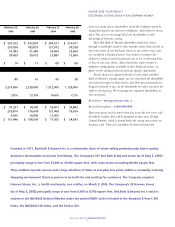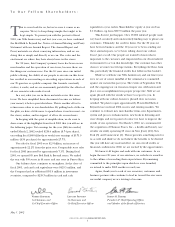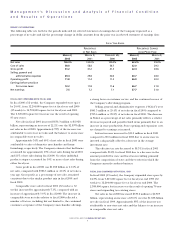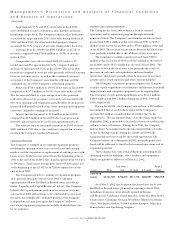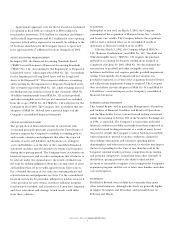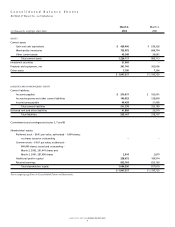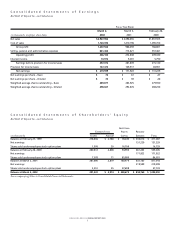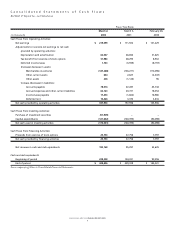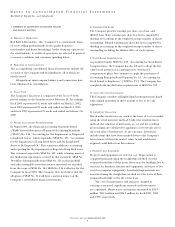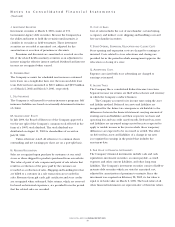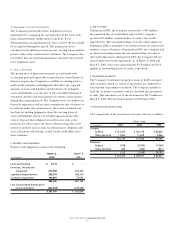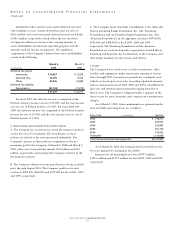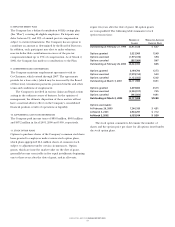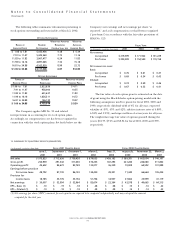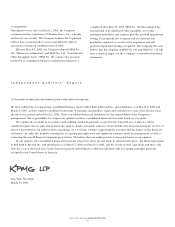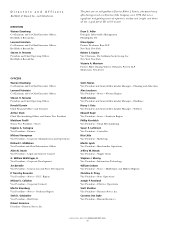Bed, Bath and Beyond 2001 Annual Report Download - page 13
Download and view the complete annual report
Please find page 13 of the 2001 Bed, Bath and Beyond annual report below. You can navigate through the pages in the report by either clicking on the pages listed below, or by using the keyword search tool below to find specific information within the annual report.
BED BATH & BEYOND ANNUAL REPORT 2001
11
T. IMPAIRMENT OF LONG-LIVED ASSETS
The Company periodically reviews long-lived assets for
impairment by comparing the carrying value of the assets with
their estimated future undiscounted cash flows. If it is
determined that an impairment loss has occurred, the loss would
be recognized during that period. The impairment loss is
calculated as the difference between asset carrying values and the
present value of the estimated net cash flows. The Company does
not believe that any material impairment currently exists related
to its long-lived assets.
U. USE OF ESTIMATES
The preparation of financial statements in conformity with
accounting principles generally accepted in the United States of
America requires the Company to establish accounting policies
and to make estimates and judgments that affect the reported
amounts of assets and liabilities and disclosure of contingent
assets and liabilities as of the date of the consolidated financial
statements and the reported amounts of revenues and expenses
during the reporting period. The Company bases its estimates on
historical experience and on other assumptions that it believes to
be relevant under the circumstances, the results of which form
the basis for making judgments about the carrying value of
assets and liabilities that are not readily apparent from other
sources. In particular, judgment is used in areas such as the
provision for sales returns, inventory valuation using the retail
inventory method, and accruals for self insurance, litigation and
store relocations and closings. Actual results could differ from
these estimates.
2. PROPERTY AND EQUIPMENT
Property and equipment consist of the following:
March 2, March 3,
(in thousands) 2002 2001
Land and building $ 5,173)$–)
Furniture, fixtures and
equipment 271,399)219,243)
Leasehold improvements 205,310)168,370)
Computer equipment 100,898)73,535)
582,780)461,148)
Less: Accumulated depreciation
and amortization (221,039) (158,492)
$ 361,741)$ 302,656)
3. LINE OF CREDIT
During fiscal 2001, the Company entered into a $50 million
uncommitted line of credit which replaced the Company’s
previous $25 million committed line of credit (“the Credit
Agreement”). The uncommitted line of credit, which expires in
September 2002, is intended to be used for letters of credit in the
ordinary course of business. During fiscal 2001, the Company had
no direct borrowings under the uncommitted line of credit or
the Credit Agreement; during fiscal 2000, the Company did not
borrow under the Credit Agreement. As of March 2, 2002 and
March 3, 2001, there were approximately $5.8 million and $2.9
million in outstanding letters of credit, respectively.
4. INVESTMENT SECURITIES
The Company’s investment securities consist of held-to-maturity
debt securities, which are stated at amortized cost, adjusted for
amortization of premium to maturity. The Company intends to
hold the securities to maturity and has classified the investment
as such. The amortized cost of the investment is $51.9 million at
March 2, 2002. The investment matures in February 2004.
5. PROVISION FOR INCOME TAXES
The components of the provision for income taxes are as follows:
FISCAL YEAR
(in thousands) 2001 2000 1999
Current:
Federal $ 123,787 $ 102,178)$ 82,652)
State and local 11,953 11,678)9,446)
135,740 113,856)92,098)
Deferred:
Federal 1,188 (3,535) (7,356)
State and local 545 (404) (841)
1,733 (3,939) (8,197)
$ 137,473 $ 109,917)$ 83,901)


